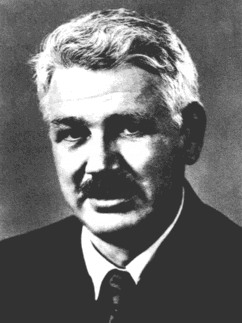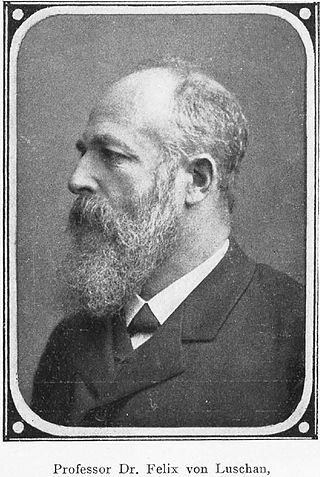Related Research Articles

Carleton Stevens Coon was an American anthropologist and professor at the University of Pennsylvania. He is best known for his scientific racist theories concerning the parallel evolution of human races, which were widely disputed in his lifetime and are considered pseudoscientific by modern science.
The Dinaric race, also known as the Adriatic race, were pseudoscientific terms used by certain physical anthropologists in the early to mid-20th century to describe the perceived predominant phenotype of the contemporary ethnic groups of southeast Europe. According to the discredited theories of physical anthropologist Carleton Coon, the Dinaric race was most commonly found among the populations in the Balkans and Carpathians, such as Montenegrins, Serbs, Bosniaks, Croats, Ghegs, Slovaks, Romanians, Hungarians, Western Ukrainians, and Southern Poles. Additionally, in Northern Europe, the South Germans were also identified as having Dinaric characteristics.
Australo-Melanesians is an outdated historical grouping of various people indigenous to Melanesia and Australia. Controversially, some groups found in parts of Southeast Asia and South Asia were also sometimes included.
The concept of race as a categorization of anatomically modern humans has an extensive history in Europe and the Americas. The contemporary word race itself is modern; historically it was used in the sense of "nation, ethnic group" during the 16th to 19th centuries. Race acquired its modern meaning in the field of physical anthropology through scientific racism starting in the 19th century. With the rise of modern genetics, the concept of distinct human races in a biological sense has become obsolete. In 2019, the American Association of Biological Anthropologists stated: "The belief in 'races' as natural aspects of human biology, and the structures of inequality (racism) that emerge from such beliefs, are among the most damaging elements in the human experience both today and in the past."
The Caucasian race is an obsolete racial classification of humans based on a now-disproven theory of biological race. The Caucasian race was historically regarded as a biological taxon which, depending on which of the historical race classifications was being used, usually included ancient and modern populations from all or parts of Europe, Western Asia, Central Asia, South Asia, North Africa, and the Horn of Africa.

Jan Czekanowski was a Polish anthropologist, statistician, ethnographer, traveller, and linguist. He was one of the first persons to use quantitative methods in linguistics.
The Nordic race is an obsolete racial concept which originated in 19th-century anthropology. It was once considered a race or one of the putative sub-races into which some late-19th to mid-20th century anthropologists divided the Caucasian race, claiming that its ancestral homelands were Northwestern and Northern Europe, particularly to populations such as Anglo-Saxons, Germanic peoples, Balts, Baltic Finns, Northern French, and certain Celts, Slavs and Ghegs. The supposed physical traits of the Nordics included light eyes, light skin, tall stature, and dolichocephalic skull; their psychological traits were deemed to be truthfulness, equitability, a competitive spirit, naivete, reservedness, and individualism. In the early 20th century, the belief that the Nordic race constituted the superior branch of the Caucasian race gave rise to the ideology of Nordicism.
The Mediterranean race is an obsolete racial classification of humans based on the now-disproven theory of biological race. According to writers of the late 19th to mid-20th centuries it was a sub-race of the Caucasian race. According to various definitions, it was said to be prevalent in the Mediterranean Basin and areas near the Mediterranean and Black Sea, especially in Southern Europe, Eastern Europe, North Africa, most of West Asia, the Middle East or Near East; western Central Asia, parts of South Asia, and parts of the Horn of Africa. To a lesser extent, certain populations of people in Ireland, western parts of Great Britain, and Southern Germany, despite living far from the Mediterranean, were thought to have some minority Mediterranean elements in their population, such as Bavaria, Wales, and Cornwall.
Nordicism is an ideology which views the historical race concept of the "Nordic race" as an endangered and superior racial group. Some notable and influential Nordicist works include Madison Grant's book The Passing of the Great Race (1916); Arthur de Gobineau's An Essay on the Inequality of the Human Races (1853); the various writings of Lothrop Stoddard; Houston Stewart Chamberlain's The Foundations of the Nineteenth Century (1899); and, to a lesser extent, William Z. Ripley’s The Races of Europe (1899). The ideology became popular in the late-19th and 20th centuries in Germanic-speaking Europe, Northwestern Europe, Central Europe, and Northern Europe, as well as in North America and Australia.
The Alpine race is an obsolete racial classification of humans based on a now-disproven theory of biological race. It was defined by some late 19th-century and early 20th-century anthropologists as one of the sub-races of the Caucasian race. The origin of the Alpine race was variously identified. Ripley argued that it migrated from Central Asia during the Neolithic Revolution, splitting the Nordic and Mediterranean populations. It was also identified as descending from the Celts residing in Central Europe in Neolithic times. The Alpine race was described as having moderate stature, neotenous features, and specific cranial measurements, such as a high cephalic index.

Felix Ritter von Luschan was a medical doctor, anthropologist, explorer, archaeologist and ethnographer born in the Austrian Empire.
Various attempts have been made, under the British Raj and since, to classify the population of India according to a racial typology. After independence, in pursuance of the government's policy to discourage distinctions between communities based on race, the 1951 Census of India did away with racial classifications. Today, the national Census of independent India does not recognise any racial groups in India.
The Irano-Afghan race or Iranid race is an obsolete racial classification of human beings based on a now-disproven theory of biological race. Some anthropologists of the 20th century classified the populations native to the Iranian plateau as belonging to this race, which was usually seen as a subrace of the Caucasian race or the Mediterranean racial subtype of that race, depending on the authority consulted.
Mongoloid is an obsolete racial grouping of various peoples indigenous to large parts of Asia, the Americas, and some regions in Europe and Oceania. The term is derived from a now-disproven theory of biological race. In the past, other terms such as "Mongolian race", "yellow", "Asiatic" and "Oriental" have been used as synonyms.

The Turanid race was a supposed sub-race of the Caucasian race in the context of a now-outdated model of dividing humanity into different races which was developed originally by Europeans in support of colonialism. The Turanid type was traditionally held to be most common among the populations native to Central Asia. The name is taken from the phylum of Turanian languages, which are the combination of the Uralic and Altaic families, hence also referred to as the term Ural–Altaic race.
Negroid is an obsolete racial grouping of various people indigenous to Africa south of the area which stretched from the southern Sahara desert in the west to the African Great Lakes in the southeast, but also to isolated parts of South and Southeast Asia (Negritos). The term is derived from now-disproven conceptions of race as a biological category.

The Races of Europe: A Sociological Study is a 1899 book published by American economist, lecturer, and racial anthropologist William Z. Ripley. The book grew out of a series of lectures he gave at the Lowell Institute at Columbia in 1896. Ripley believed that race was critical to understanding human history, though his work afforded environmental and non-biological factors, such as traditions, a strong weight as well. He believed, as he wrote in the introduction to The Races of Europe, that:
The Atlantid race or North-Atlantid is an obsolete racial classification of human beings based on a now-disproven theory of biological race. In the early 20th century, it was described as one of the sub-races of the Caucasoid race, a blend of the Nordic and Mediterranean races.
The history of anthropometry includes its use as an early tool of anthropology, use for identification, use for the purposes of understanding human physical variation in paleoanthropology and in various attempts to correlate physical with racial and psychological traits. At various points in history, certain anthropometrics have been cited by advocates of discrimination and eugenics often as part of novel social movements or based upon pseudoscience.
The Indid race is an obsolete racial classification of human beings based on a now-disproven theory of biological race. In anthropological literature of the 19th and 20th centuries, the populations of the Indian subcontinent were classified as belonging to this race, which was categorized as belonging to the Mediterranean type of the greater Caucasoid race.
References
- ↑ For the model of dividing humanity into races, see American Association of Physical Anthropologists (27 March 2019). "AAPA Statement on Race and Racism". American Association of Physical Anthropologists. Retrieved 19 June 2020.
Instead, the Western concept of race must be understood as a classification system that emerged from, and in support of, European colonialism, oppression, and discrimination.
- ↑ Ripley, William Z. (1899). The Races of Europe: A Sociological Study. D. Appleton & Company. p. 444.
- ↑ Luschan, Felix Von (1911). "The Early Inhabitants of Western Asia". The Journal of the Royal Anthropological Institute of Great Britain and Ireland. 41. Royal Anthropological Institute of Great Britain and Ireland: 242. doi:10.2307/2843172. hdl: 2027/uc2.ark:/13960/t4nk3d322 . JSTOR 2843172.
When I first upheld in 1892, in my paper on the anthropological position of the Jews, the homogeneous character of these groups, I called them "Armenoids." But there can be no doubt that they are all descended from tribes belonging to the great Hittite Empire
- ↑ Petersen, Eugen; Luschan, Felix von. Lykien, Milyas und Kibyratis (1889).
- ↑ Grintz, J. M. (1962). "On the Original Home of the Semites". Journal of Near Eastern Studies. 21 (3): 186–206. doi:10.1086/371692. ISSN 0022-2968.
- ↑ Morris-Reich (2013). "Photography in Economies of Demonstration: The Idea of the Jews as a Mixed-Race People". Jewish Social Studies. 20 (1): 150. doi:10.2979/jewisocistud.20.1.150.
- ↑ Morris-Reich, A. (2013-01-01). "Taboo and Classification: Post-1945 German Racial Writing on Jews". The Leo Baeck Institute Yearbook. 58 (1): 195–215. doi:10.1093/leobaeck/ybt015. ISSN 0075-8744.
- 1 2 Bartulin, Nevenko (2009-12-21). "The ideal Nordic – Dinaric racial type: Racial anthropology in the Independent State of Croatia". Review of Croatian History. V (1): 189–219. ISSN 1845-4380.
- ↑ Fisher, William B. (2003). The Middle East and North Africa, Volume 50. Routledge. p. 444. ISBN 978-1-85743-184-1.
The northern and eastern hill districts [of Iraq] contain many racial elements—Turkish, Persian, and proto-Nordic, with Armenoid strains predominating. […] the population of the riverine districts of Iraq displays a mixture of Armenoid and Mediterranean elements. North of the Baghdad district the Armenoid strain is dominant.
- ↑ Fisher, William B. (1966). The Middle East: A Physical, Social and Regional Geography. Methuen. p. 96. ISBN 978-0-416-71510-1.
Armenoid affinities are easily discerned in the peoples of northern, central and south-eastern Iraq.
, extract of page 444